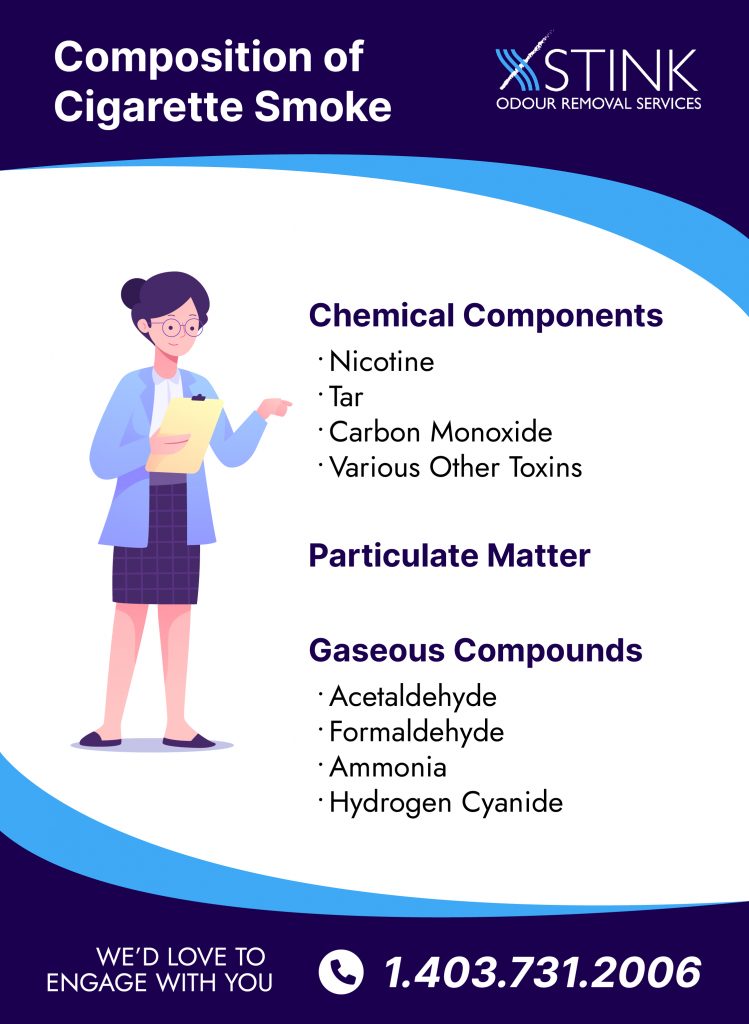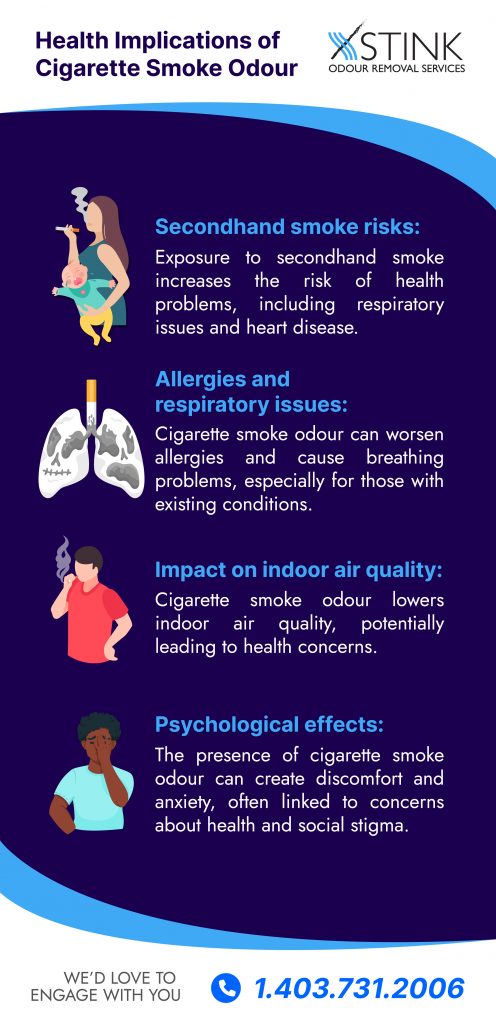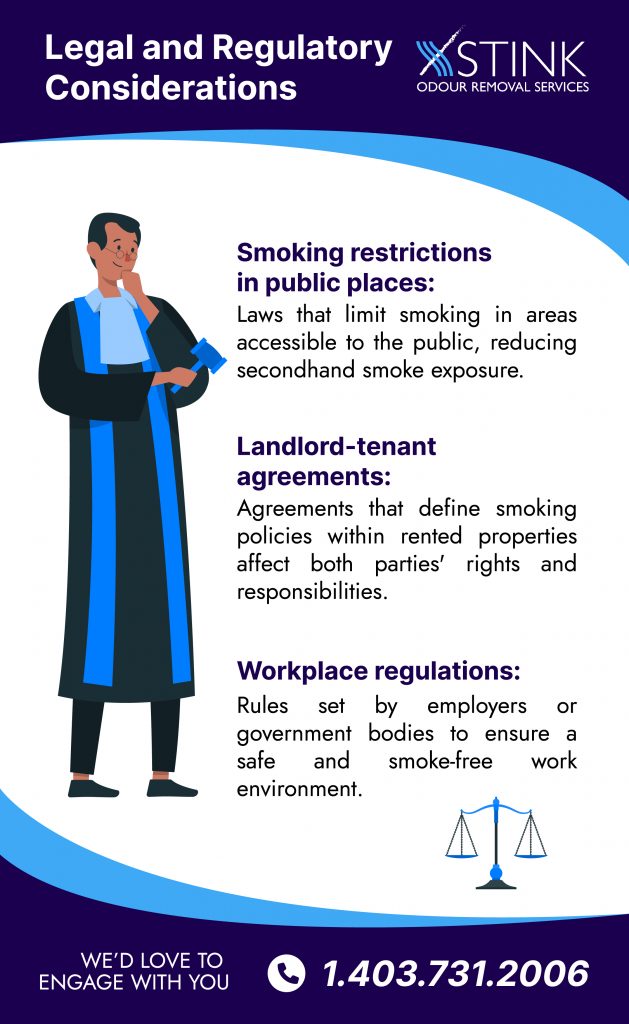An In-Depth Guide: Understanding Cigarette Smoke Odour

Understanding cigarette smoke odour is crucial in addressing the challenges it poses to indoor environments and public health in Alberta, Canada.
The unmistakable scent of cigarette smoke, often described as acrid and stale, can be both unpleasant and persistent.
This blog post will delve into the intricacies of understanding cigarette smoke odour and explore various aspects related to its composition, health implications, detection, and mitigation.
Whether you are a smoker trying to reduce the impact of your habit on your surroundings or a non-smoker concerned about secondhand smoke exposure, gaining insights into cigarette smoke odour is essential for creating cleaner, healthier, and more comfortable living and working spaces.
An Overview of Cigarette Smoke Odour
Cigarette smoke odour refers to the distinctive and often unpleasant smell produced by the combustion of tobacco in cigarettes.
It is a complex and potent mixture of chemical compounds and particulate matter that lingers in the air and attaches to various surfaces.
This odour can be challenging to remove and has significant implications for indoor air quality, human health, and overall quality of life.
Understanding the nature and characteristics of cigarette smoke odour is crucial in addressing its effects and developing effective strategies for control and mitigation.
Importance of Understanding Cigarette Smoke Odour
Recognizing the importance of understanding cigarette smoke odour is essential for several reasons.
Firstly, it directly affects the health and well-being of individuals exposed to it, whether through active smoking or exposure to secondhand smoke.
Second, it has significant implications for indoor environments, including homes, workplaces, and public spaces, where the presence of cigarette smoke odour can create discomfort and health risks.
Additionally, understanding cigarette smoke odour is vital for policymakers, property owners, and health professionals to implement appropriate regulations, strategies, and interventions to mitigate its impact.
Therefore, delving into the intricacies of cigarette smoke odour is essential to comprehensively address the associated health and environmental challenges.
Cigarette smoke odour, a complex and lingering mixture of chemical compounds, has significant implications for indoor air quality and public health, making it crucial to understand its nature and characteristics for effective control and mitigation strategies.
Composition of Cigarette Smoke

Chemical Components
Cigarette smoke is a complex mixture of chemicals that are produced when tobacco is burned.
These chemicals can be categorized into several groups, each with its own unique characteristics and potential health effects.
Understanding the chemical composition of cigarette smoke is vital for assessing its harmful properties and the risks associated with smoking.
Nicotine
Nicotine is one of the most well-known and addictive components of cigarette smoke.
It is a stimulant that affects the central nervous system, leading to increased heart rate and blood pressure and the release of neurotransmitters like dopamine.
Nicotine addiction is a significant factor in the persistence of smoking habits and the difficulty of quitting.
Over time, it can lead to various health problems, including cardiovascular diseases, cancer, and addiction-related challenges.
Tar
Tar is a dark, sticky substance that is a byproduct of burning tobacco.
It contains numerous carcinogens (cancer-causing agents) and is responsible for staining teeth, fingers, and lung tissues in smokers.
The deposition of tar in the respiratory tract is a primary factor in the development of smoking-related diseases, such as lung cancer and chronic obstructive pulmonary disease (COPD).
Carbon Monoxide
Carbon monoxide (CO) is a colourless, odourless gas present in cigarette smoke.
It binds to hemoglobin in the blood more readily than oxygen, reducing the oxygen-carrying capacity of the blood.
As a result, smokers are at risk of reduced oxygen supply to body tissues, leading to fatigue and increased strain on the heart.
Long-term exposure to carbon monoxide can have severe health consequences, particularly for those with preexisting cardiovascular conditions.
Various Other Toxins
In addition to nicotine, tar, and carbon monoxide, cigarette smoke contains a multitude of other toxic chemicals, including formaldehyde, acetaldehyde, ammonia, and hydrogen cyanide.
These compounds can irritate the respiratory system, damage DNA, and contribute to the development of cancer and other diseases.
Some of these toxins also play a role in the characteristic odour of cigarette smoke, making it both noxious and harmful.
Particulate Matter
Particulate matter in cigarette smoke consists of tiny solid particles and liquid droplets suspended in the air.
These particles vary in size, with some being fine enough to penetrate deep into the lungs.
Particulate matter in cigarette smoke is a complex mixture that includes ash, soot, and various organic compounds.
When inhaled, these particles can irritate the respiratory system, trigger inflammation, and contribute to the development of respiratory diseases such as chronic bronchitis and emphysema.
They can also settle on surfaces, leading to the characteristic staining and odour associated with cigarette smoke.
Gaseous Compounds
Cigarette smoke contains a range of gaseous compounds that are released during the combustion of tobacco.
These gases contribute to the overall composition of cigarette smoke and have distinct properties and health effects.
Acetaldehyde
Acetaldehyde is a colourless gas with a pungent, fruity odour. It is a known carcinogen and irritant to the respiratory system.
Prolonged exposure to acetaldehyde can damage DNA and increase the risk of cancer, particularly in the mouth, throat, and respiratory tract.
It also plays a role in the formation of acetaldehyde-derived DNA adducts, which are associated with tobacco-related cancer.
Formaldehyde
Formaldehyde is a strong-smelling gas and a well-established carcinogen.
It can cause irritation of the eyes, nose, and throat when inhaled and has been linked to respiratory problems.
Formaldehyde exposure from cigarette smoke is concerning, as it can react with other compounds in the smoke to form potentially harmful substances.
Prolonged exposure to formaldehyde is associated with an increased risk of cancer, particularly in the respiratory tract.
Ammonia
Ammonia is a colourless gas with a strong, pungent odour.
It is added to some tobacco products to enhance the absorption of nicotine into the bloodstream.
Ammonia can irritate the respiratory system and contribute to the addictive nature of cigarettes by facilitating the rapid delivery of nicotine to the brain.
Hydrogen Cyanide
Hydrogen cyanide is a toxic gas that interferes with the body’s ability to use oxygen properly.
It is a product of tobacco combustion and can lead to a decreased oxygen supply to body tissues, potentially resulting in fatigue and stress on the heart.
Long-term exposure to hydrogen cyanide is associated with an increased risk of cardiovascular diseases and other health problems.
Cigarette smoke is a complex mixture of chemicals, including nicotine, tar, carbon monoxide, and numerous other toxins, all of which pose various health risks. Understanding this chemical composition is crucial in evaluating the harmful properties of smoking and its impact on health.
Mechanisms of Cigarette Smoke Odour
How Odour Molecules Are Released
The release of odour molecules in cigarette smoke is a complex process that begins with the combustion of tobacco.
When a cigarette is lit, the high temperatures generated cause the chemical compounds within the tobacco to undergo various reactions, including pyrolysis.
These reactions break down the tobacco’s organic matter, releasing volatile organic compounds (VOCs) into the air.
These VOCs are responsible for the distinct smell of cigarette smoke.
As the smoke is exhaled by the smoker and diffuses into the environment, these volatile molecules disperse and become airborne.
They can also attach themselves to nearby surfaces, leading to the pervasive odour associated with smoking.
Interaction with Indoor Surfaces
Cigarette smoke odour can remarkably interact with indoor surfaces, including walls, furniture, curtains, and carpets.
This interaction occurs because the odour molecules in the smoke are often hydrophobic, meaning they have an affinity for surfaces with high surface area and low polarity.
As smoke particles settle on these surfaces, they can adsorb and absorb into them.
Over time, this leads to the accumulation of odour molecules, making it challenging to eliminate the smell.
The porous nature of many indoor materials allows smoke odour to penetrate deeply, making it more persistent and difficult to remove compared to other types of odours.
Persistence and Longevity
The persistence and longevity of cigarette smoke odour are notable characteristics that make it particularly troublesome for indoor environments.
Unlike some odours that dissipate relatively quickly, cigarette smoke odour can endure for extended periods.
This persistence is due to the combination of factors such as the chemical composition of the odour molecules, their strong affinity for surfaces, and their ability to become trapped in materials.
Even after smoking has ceased in space, the residual odour can linger, affecting the indoor air quality and the comfort of individuals in the area.
Effective removal of cigarette smoke odour often requires a combination of thorough cleaning, ventilation, and the use of odour-neutralizing products to break down and remove these stubborn odour molecules.
Understanding cigarette smoke odour involves recognizing that it is released through the combustion of tobacco, attaches to indoor surfaces due to its chemical properties, and exhibits remarkable persistence, making it challenging to eliminate without targeted strategies such as cleaning, ventilation, and odour-neutralization.
Factors Influencing Odour Intensity
Type of Cigarette
The type of cigarette being smoked significantly influences the intensity of cigarette smoke odour.
Different cigarette brands and varieties may contain varying levels of additives, flavours, and tobacco blends. These differences can result in distinct odour profiles.
For example, menthol cigarettes may emit a minty or cooling scent, while flavoured cigarettes can have a sweet or fruity aroma.
Additionally, the use of additives or filters can alter the composition of the smoke and affect how odour molecules are released and perceived.
Therefore, the type of cigarette a smoker chooses can directly impact the strength and character of the resulting smoke odour.
Ventilation and Air Circulation
Ventilation and air circulation play a critical role in determining the intensity and persistence of cigarette smoke odour in indoor environments.
Adequate ventilation systems, such as exhaust fans or air purifiers, can help remove smoke particles and odour from the air more effectively.
Poor ventilation can lead to the accumulation of smoke and odour, making it more challenging to maintain clean indoor air quality.
In spaces with efficient ventilation, the odour may dissipate more quickly, reducing its overall intensity.
Proper air circulation can also prevent smoke particles from settling on surfaces, further minimising the persistence of the odour.
Surface Materials
The materials used in indoor spaces can influence how cigarette smoke odour interacts and lingers.
Porous materials, such as carpets, upholstery, and curtains, have a greater capacity to absorb and retain odour molecules.
This can result in a more pronounced and persistent odour in areas furnished with such materials.
In contrast, non-porous surfaces like glass, metal, and sealed wood are less likely to trap odour molecules, making cleaning and removing the smell easier.
The choice of surface materials in interior design, therefore, has a significant impact on how cigarette smoke odour is perceived within a space.
Proper selection and maintenance of materials can help mitigate the intensity of the odour.
Human Factors
Sensitivity to Odour
Individuals vary in their sensitivity to odours, including cigarette smoke odour.
Some people have a heightened sense of smell and are more likely to detect even faint traces of smoke odour, while others may be less sensitive and less bothered by it.
This variation in sensitivity can influence how intensely cigarette smoke odour is perceived.
Highly sensitive people may find the odour more unpleasant and intrusive, even at lower concentrations.
Conversely, individuals with reduced sensitivity may be less aware of the odour or less affected by its presence.
Smoking Habits
Smoking habits can significantly impact the intensity of cigarette smoke odour in indoor environments.
Active smokers who smoke regularly contribute more to the overall odour because they release smoke continuously.
Moreover, they may become desensitised to the odour, making them less aware of its intensity.
Passive or occasional smokers, on the other hand, may be more sensitive to the odour, as they are not accustomed to it and may find it more bothersome.
Smoking habits, including the frequency and duration of smoking sessions, affect how the odour is experienced and perceived by both smokers and non-smokers.
Cleanliness
Clean indoor spaces play a critical role in managing cigarette smoke odour intensity.
Regular cleaning and maintenance help remove smoke particles that settle on surfaces, reducing the persistence of the odour.
Stale smoke odour is more likely to accumulate in spaces that are not adequately cleaned, resulting in a stronger and more offensive smell.
Additionally, smokers’ personal hygiene and cleanliness practices can impact odour intensity.
Smokers who take steps to reduce the presence of smoke residue on their clothing, hair, and skin are less likely to carry the odour with them and spread it to indoor environments.
Cigarette smoke odour intensity is influenced by factors like the type of cigarette, ventilation, indoor materials, individual sensitivity, smoking habits, and cleanliness. Understanding these factors is crucial for effectively managing and reducing smoke odour in indoor spaces.
Health Implications
Secondhand Smoke Risks
Secondhand smoke, also known as passive or environmental tobacco smoke, poses significant health risks to individuals exposed to it, particularly in enclosed spaces.
Secondhand smoke contains many of the same harmful chemicals and toxins found in direct cigarette smoke, albeit in lower concentrations.
Prolonged exposure to secondhand smoke is associated with an increased risk of respiratory illnesses, cardiovascular diseases, and even cancer.
Children, pregnant women, and non-smokers are particularly vulnerable to these risks.
Understanding these health implications is crucial for advocating smoke-free environments and protecting the health of those exposed to secondhand smoke.

Allergies and Respiratory Issues
Cigarette smoke odour can trigger allergies and exacerbate respiratory issues in individuals who are sensitive to it.
The odour contains particulate matter and irritants that can lead to symptoms such as sneezing, coughing, wheezing, and shortness of breath, especially in individuals with asthma or other respiratory conditions.
Exposure to cigarette smoke odour can worsen these conditions and reduce the overall quality of life for affected individuals.
For those with allergies, the odour can act as a potent allergen, leading to allergic reactions and discomfort.
Therefore, understanding the potential for cigarette smoke odour to worsen allergies and respiratory issues is essential for managing indoor environments effectively.
Impact on Indoor Air Quality
Cigarette smoke odour significantly impacts indoor air quality by introducing a range of harmful chemicals and particles into the environment.
This deterioration in air quality can lead to discomfort and health problems for occupants of the space.
Even after smoking has ceased, residual odour and pollutants can linger, affecting the overall freshness and safety of the indoor air.
Poor indoor air quality resulting from cigarette smoke odour, is linked to an increased risk of respiratory infections, exacerbation of preexisting conditions, and general discomfort.
Thus, understanding the impact of cigarette smoke odour on indoor air quality is vital for promoting healthier living and working environments.
Psychological Effects
Cigarette smoke odour can have psychological effects on individuals who are exposed to it.
The odour is often associated with negative connotations, such as health risks and social stigma.
This association can lead to feelings of discomfort, anxiety, and annoyance in non-smokers, even if they are not directly affected by the health risks of smoking.
Moreover, the persistent presence of cigarette smoke odour in indoor spaces can contribute to stress and reduce overall well-being.
Understanding the psychological impact of cigarette smoke odour is important for addressing the physical health consequences and the emotional and mental aspects of exposure.
Cigarette smoke odour can have substantial health implications, including risks related to secondhand smoke exposure, allergies, compromised indoor air quality, and psychological effects. Addressing these concerns is crucial for safeguarding the well-being and comfort of individuals in indoor spaces.
Detecting and Measuring Cigarette Smoke Odour
Human Perception
Human perception is a fundamental means of detecting cigarette smoke odour.
People can generally detect the presence of cigarette smoke odour through their sense of smell.
However, individual sensitivity to odours varies, and some may be more adept at detecting even faint traces of smoke odour, while others may be less sensitive.
When individuals are exposed to cigarette smoke odour, they often describe it as acrid, stale, or pungent.
The strength of the perception depends on factors such as the concentration of odour molecules in the air, the cleanliness of the environment, and the individual’s sensitivity.
Human perception is valuable for immediate detection but may not provide precise quantification of odour intensity.
Odour Measurement Devices
To quantitatively assess the intensity of cigarette smoke odour, odour measurement devices and instruments are employed.
These devices use various methodologies, such as gas chromatography, mass spectrometry, or electronic nose technology, to analyse the chemical composition and concentration of odour molecules in the air.
Some of these devices are capable of providing real-time measurements and data that can be used to assess odour levels objectively.
They are particularly useful in research settings, industrial hygiene assessments, and regulatory compliance evaluations.
Odour measurement devices help provide precise and quantitative information about the intensity of cigarette smoke odour, which can be important for scientific studies and indoor air quality assessments.
Professional Assessments
Professional assessments of cigarette smoke odour are often conducted by experts in the field of indoor air quality, environmental health, or odour assessment.
These assessments involve thorough inspections of indoor spaces to evaluate the presence and intensity of odour.
Professionals may use both human sensory evaluation and specialised odour measurement devices to assess the situation comprehensively.
These assessments can be valuable in situations where there are concerns about indoor air quality, such as in workplaces, hospitality establishments, or rental properties.
Professional assessments provide a holistic view of the odour situation, combining both objective measurements and expert judgment to determine the extent of the problem and recommend appropriate mitigation strategies.
Cigarette smoke odour can be detected through human perception, but its intensity varies among individuals. Odour measurement devices offer precise quantitative data, while professional assessments provide comprehensive evaluations, combining expert judgment and objective measurements to address odour issues effectively in various indoor settings.
Removing and Reducing Cigarette Smoke Odour
Cleaning Strategies
Surface Cleaning
Surface cleaning is essential in removing and reducing cigarette smoke odour in indoor spaces.
Smoke particles and odour molecules often settle on various surfaces, including walls, ceilings, furniture, and hard floors.
To effectively remove the odour, thorough surface cleaning is required. This typically involves using appropriate cleaning agents to scrub and wash surfaces where smoke residue has accumulated.
Additionally, attention should be paid to cleaning air vents, light fixtures, and any other areas where smoke particles may have settled.
Regular and systematic surface cleaning helps eliminate the source of odour and prevents its persistence in indoor environments.
Fabric Cleaning
Fabrics, such as curtains, upholstery, carpets, and clothing, can absorb and trap cigarette smoke odour molecules.
Therefore, fabric cleaning is a critical aspect of odour removal.
Depending on the type of fabric, cleaning methods may include vacuuming, washing, or dry cleaning.
In some cases, fabric deodorizers or odour-neutralizing products can be used to further reduce the odour’s intensity.
Following manufacturer recommendations for fabric care and cleaning products is essential to avoid damaging the materials while effectively eliminating the odour.
By addressing fabric surfaces, you can significantly reduce the persistence of cigarette smoke odour in indoor spaces.
Ventilation and Air Purification
Ventilation and air purification are essential strategies for removing and reducing cigarette smoke odour in indoor environments.
Proper ventilation involves the exchange of indoor air with fresh outdoor air, diluting and removing odorous particles in the process.
Effective ventilation systems, such as exhaust fans and open windows, can help in the removal of smoke odour.
Air purification systems, including HEPA (High-Efficiency Particulate Air) filters and activated carbon filters, are designed to capture and eliminate smoke particles and odour molecules from the air.
Additionally, air purifiers equipped with ozone generators can break down odour molecules.
The combination of proper ventilation and air purification can significantly improve indoor air quality and reduce the lingering odour of cigarette smoke.
Odour-Neutralizing Products
Odour-neutralizing products are specifically designed to target and eliminate odour molecules, including those found in cigarette smoke.
These products work by chemically altering or encapsulating the odour molecules, rendering them non-volatile and no longer detectable by the human nose.
Common types of odour-neutralizing products include aerosol sprays, gels, sachets, and activated charcoal products.
Some products release fragrances to mask the odour temporarily, while others work to neutralize it at a molecular level.
Odour-neutralizing products can be used in various indoor spaces, including homes, offices, and vehicles.
When chosen and applied correctly, these products can be effective in reducing cigarette smoke odour and providing a fresher indoor environment.
To remove and reduce cigarette smoke odour, focus on thorough surface cleaning, including walls and fabrics, ensure proper ventilation and air purification, and consider using odour-neutralizing products. These strategies can effectively eliminate odour sources and enhance indoor air quality.
Legal and Regulatory Considerations
Smoking Restrictions in Public Places

Smoking restrictions in public places refer to laws and regulations that limit or prohibit smoking in areas accessible to the general public.
These restrictions aim to protect non-smokers from secondhand smoke exposure and promote healthier environments.
In many countries, smoking is prohibited in indoor public spaces like restaurants, bars, airports, and public transportation.
Additionally, there are often designated smoking areas or zones where smoking is permitted.
Understanding these restrictions is crucial for both smokers and non-smokers to ensure compliance and maintain a smoke-free and odour-free atmosphere in public spaces.
Landlord-Tenant Agreements
Landlord-tenant agreements play a significant role in addressing cigarette smoke odour in rental properties.
Landlords often have the authority to include clauses in rental agreements that specify whether smoking is allowed or prohibited within rental units.
Tenants are typically bound by these agreements, and violation of no-smoking clauses can result in eviction.
For tenants, it is essential to review rental agreements carefully and abide by the smoking policies established by landlords.
For landlords, clear and enforceable policies regarding smoking can help prevent cigarette smoke odour issues and maintain the overall condition of rental properties.
Workplace Regulations
Workplace regulations related to cigarette smoke odour focus on ensuring a safe and healthy working environment for employees.
Many countries have workplace regulations that restrict or prohibit smoking indoors, including in office buildings, factories, and other workspaces.
These regulations often require employers to establish designated smoking areas outside of the workplace to minimize exposure to secondhand smoke and odour.
Compliance with workplace regulations is essential for both employers and employees to create a conducive and safe work environment.
Understanding and adhering to these regulations is necessary to prevent health hazards associated with cigarette smoke and maintain productive workplaces.
FAQs in Relation to Understanding Cigarette Smoke Odour
Why does cigarette smoke have such a distinctive and persistent odour?
Cigarette smoke contains a complex mixture of chemicals, including volatile organic compounds (VOCs) and tar, which can become trapped in indoor surfaces and materials.
The persistence of the odour is due to the strong affinity of these compounds for surfaces, making it challenging to remove completely.
How can I reduce cigarette smoke odour in my home?
To reduce cigarette smoke odour in your home, you can take several steps, including implementing proper ventilation, using air purifiers, cleaning surfaces regularly, washing fabrics, and using odour-neutralizing products designed to target and eliminate odour molecules.
Is secondhand smoke odour harmful to my health?
While the odour itself is not harmful, secondhand smoke contains toxins and carcinogens.
Exposure to secondhand smoke, even in the absence of odour, can pose serious health risks, including respiratory issues, heart disease, and an increased risk of cancer.
Can the odour from smoking permeate walls and other surfaces?
Yes, cigarette smoke odour can penetrate and adhere to various indoor surfaces, including walls, ceilings, furniture, and fabrics.
The porous nature of some materials allows odour molecules to become trapped, making it necessary to clean and deodorize these surfaces thoroughly.
What are some effective odour-neutralizing products for combating cigarette smoke odour?
Effective odour-neutralizing products include aerosol sprays, gels, activated charcoal products, and sachets specifically designed to target and neutralize odour molecules.
These products work by chemically altering or encapsulating the odour molecules, rendering them less detectable to the human nose.
Understanding Cigarette Smoke Odour Is Crucial for Healthier Indoor Spaces!
In conclusion, understanding cigarette smoke odour is not just a matter of sensory perception; it encompasses a range of scientific, health, and regulatory considerations.
We’ve explored its composition, associated health risks, and strategies to remove and reduce its presence in indoor spaces.
However, for those facing persistent and challenging odour issues, seeking professional help can be a transformative step.
If you find yourself grappling with the tenacity of cigarette smoke odour in your home, workplace, or rental property, consider consulting with experts from XStink Odour Removal Services in odour assessment and remediation.
Professionals in indoor air quality, environmental health, and odour control possess the knowledge and tools necessary to identify the extent of the problem and implement effective solutions.
Whether it’s conducting thorough assessments, recommending targeted cleaning strategies, or advising on the use of odour-neutralizing products, their expertise can make a significant difference.
So, take action today to improve the quality of your indoor environment and protect the well-being of those exposed to cigarette smoke odour.
Seek out professional help when needed, and together, we can create healthier, fresher, and more odour-free spaces for everyone.




